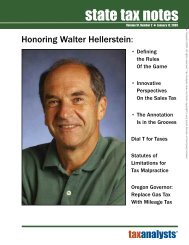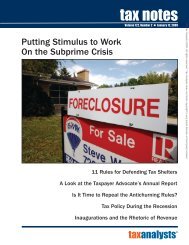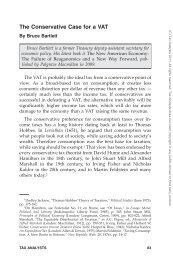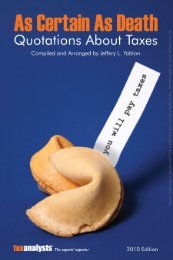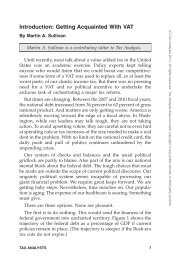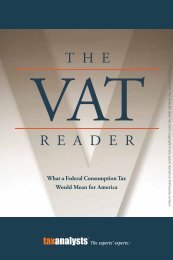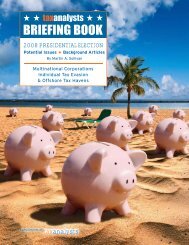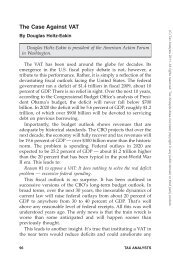Forty Years of Change, One Constant: Tax Analysts
Forty Years of Change, One Constant: Tax Analysts
Forty Years of Change, One Constant: Tax Analysts
You also want an ePaper? Increase the reach of your titles
YUMPU automatically turns print PDFs into web optimized ePapers that Google loves.
<strong>Forty</strong> <strong>Years</strong> <strong>of</strong> <strong>Change</strong>, <strong>One</strong> <strong>Constant</strong>: <strong>Tax</strong> <strong>Analysts</strong><br />
could periodically claim credit for cutting taxes<br />
when all they were really doing was compensating<br />
for bracket creep. From a political point <strong>of</strong> view, the<br />
tax issue had little salience.<br />
The business community benefited from the<br />
lack <strong>of</strong> indexing. Legislation that reduced personal<br />
income taxes typically included business tax reductions<br />
as well. There was no need to search for<br />
business tax increases to pay for personal income tax<br />
reductions.<br />
Contrast the situation today. With indexing, tax<br />
cuts really do erode the revenue base, and we face<br />
a serious issue <strong>of</strong> fiscal sustainability. <strong>Tax</strong> reduction<br />
appears unavailable as a tool to combat even<br />
an extraordinarily severe recession. The tax issue is<br />
front and center in our political competition. The tax<br />
legislative process devotes much time and energy to<br />
searching for ways to raise revenue from businesses<br />
to pay for personal tax reductions — all as a result <strong>of</strong><br />
a couple <strong>of</strong> floor amendments.<br />
Roger Wheeler<br />
Landrum, S.C.<br />
It was almost 40 years ago that I, as a recent<br />
graduate <strong>of</strong> Georgetown University Law School,<br />
joined the multinational corporation for which I<br />
would work some 35 years, the last 15 years as its<br />
chief tax <strong>of</strong>ficer.<br />
At that time, tax staff management consisted<br />
exclusively <strong>of</strong> older men with graying hair, wearing<br />
dark blue suits. They barked orders that were carried<br />
out by younger men, neatly groomed and wearing<br />
similar blue suits. There were a goodly number <strong>of</strong><br />
women on the staff, but they were either secretaries<br />
or secretaries who seemingly couldn’t take dictation<br />
well enough so were made duty drawback clerks in<br />
the customs department. If a woman was in a supervisory<br />
position, most likely it was overseeing some<br />
kind <strong>of</strong> processing activity like filing state and local<br />
tax returns.<br />
Over time things began to change: Women<br />
became lawyers and CPAs, human resources<br />
departments initiated diversity training followed<br />
by quota-like staffing guidelines, existing male<br />
management began to appreciate the large and<br />
capable untapped female potential. And, <strong>of</strong> course,<br />
there were a few trailblazers, both male and female,<br />
who championed the initiative at critical times. More<br />
important, however, was the compelling logic that a<br />
more diverse workforce was a better workforce. The<br />
beauty <strong>of</strong> it is that no one now even gives a second<br />
thought to women in the tax practice.<br />
Today, at least from my vantage point, women are<br />
almost as equally represented in the tax practice as<br />
men — as chief tax <strong>of</strong>ficers in major corporations,<br />
partners in the most respected law and accounting<br />
firms, thought leaders in academia, and key policymakers<br />
holding down important posts on Capitol<br />
Hill and at Treasury and the IRS. In numbers and<br />
importance, if you ask me, women have pretty much<br />
achieved parity, and this is one <strong>of</strong> the biggest (and<br />
most welcome) changes over the past 40 years. I<br />
hope I was an enabler along the way.<br />
George White<br />
<strong>Tax</strong> <strong>Analysts</strong><br />
Falls Church, Va.<br />
Tom Field was not always the highly regarded<br />
figure in the tax world that he is today. Back in the<br />
day when he was shattering the insular world <strong>of</strong><br />
D.C. tax practice, he was mighty unpopular with<br />
both the IRS and tax practitioners. As is well known,<br />
the IRS fought Tom’s efforts to achieve transparency<br />
at every step <strong>of</strong> the way before yielding to judicial<br />
decisions. Not so well known is Tom’s disfavor<br />
among tax practitioners who might have been expected<br />
to embrace his efforts. They didn’t, at least in<br />
the D.C. tax practices <strong>of</strong> the major accounting firms.<br />
We were comfortable with the way the IRS handled<br />
the private letter ruling program, with its definite<br />
emphasis on “private.”<br />
There was no publication <strong>of</strong> PLRs, but news<br />
<strong>of</strong> novel rulings managed to circulate by word <strong>of</strong><br />
mouth among the Big Eight(!) accounting firms. If,<br />
for example, Arthur Young (the firm where I was a<br />
partner) got an interesting spin<strong>of</strong>f ruling, we might<br />
let a friendly competitor know how the IRS was<br />
ruling on a particular issue. All that changed when<br />
the IRS was forced to publicize PLRs. The expectation<br />
among practitioners was that it would have<br />
a chilling effect on the IRS’s willingness to issue<br />
PLRs and on clients’ willingness to risk disclosure.<br />
In any event, publication turned out to be a mixed<br />
bag. The PLR program continued, but the required<br />
redaction <strong>of</strong> identifying details greatly reduced its<br />
usefulness to readers.<br />
25



